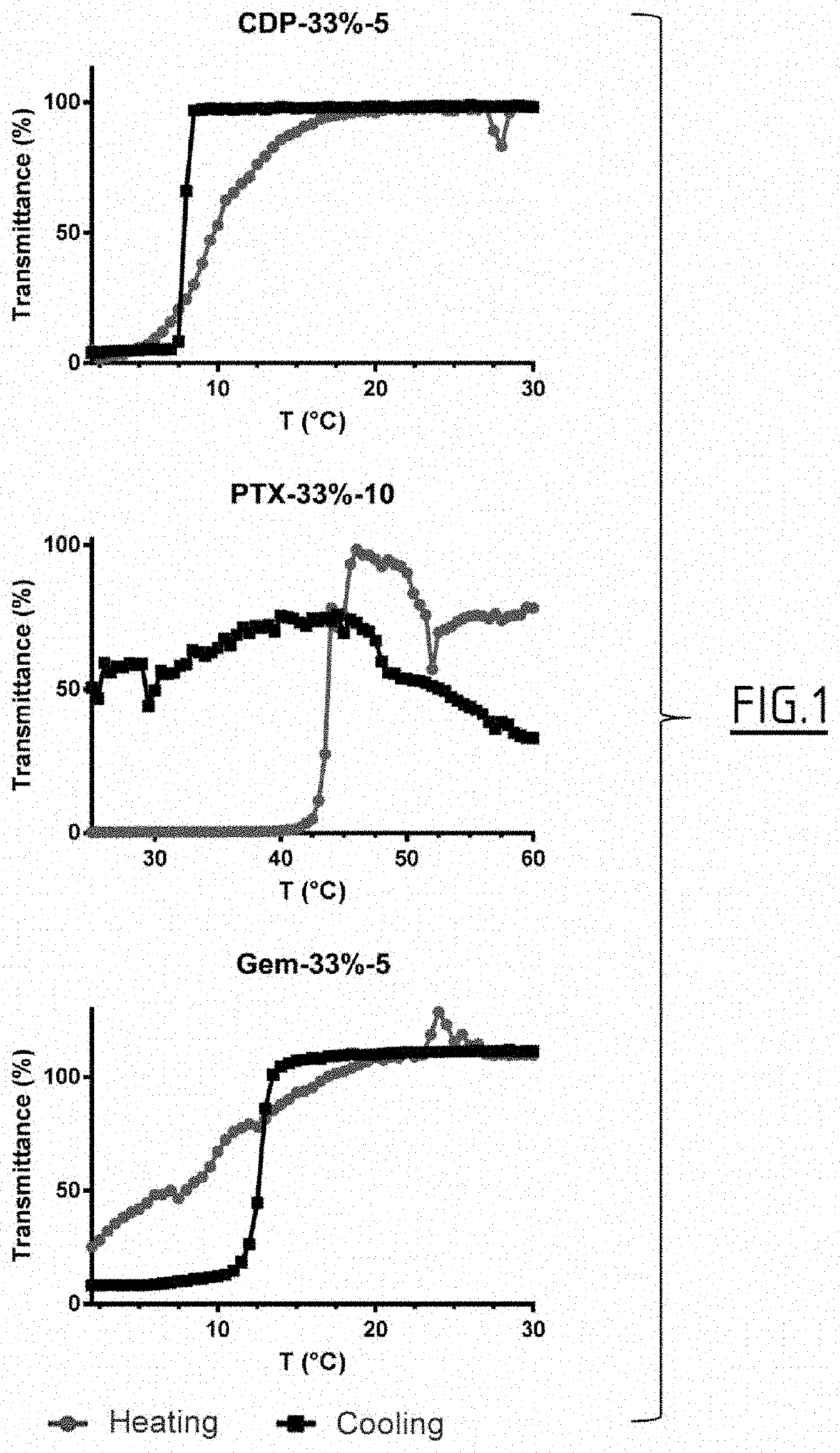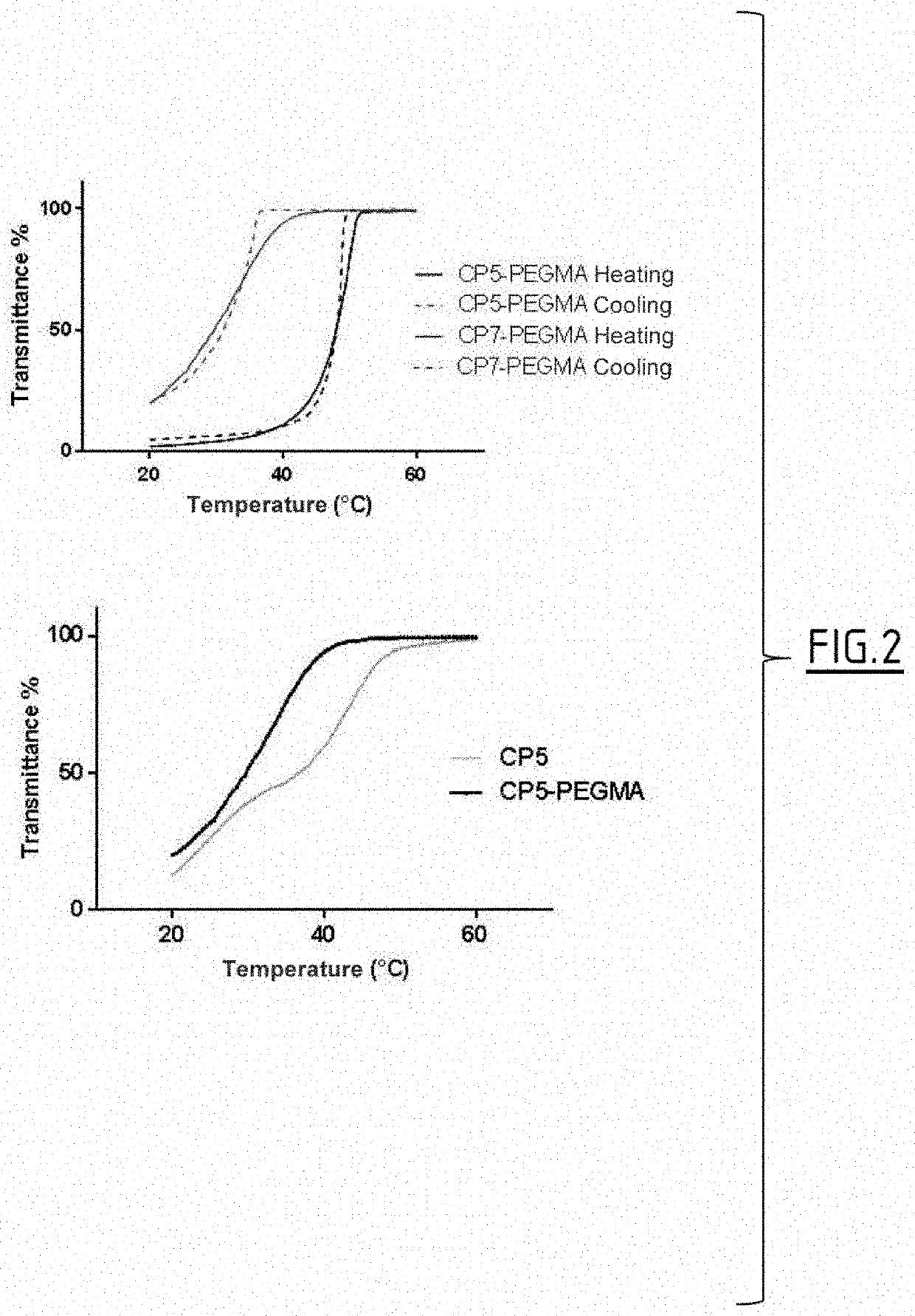Polymeric prodrugs and subcutaneous and/or intramuscular administration thereof
a polymer prodrug and subcutaneous and/or intramuscular technology, applied in the direction of pharmaceutical delivery mechanism, organic active ingredients, drug compositions, etc., can solve the problems of inability to administer subcutaneously or intramuscularly, inability to meet current doses of chemotherapy, and low injection volume inherent in sc administration, etc., to achieve easy injection and increase the viscosity of the formulation
- Summary
- Abstract
- Description
- Claims
- Application Information
AI Technical Summary
Benefits of technology
Problems solved by technology
Method used
Image
Examples
example 1
of Paclitaxel (PTX) to the Control Agent 4-Cyano-4-[(Dodecylsulfanylthiocarbonyl)Sulfanyl]Pentanoic (CDP)
[0322]The following example presents the chemical modification of the CDP control agent so that it is linked to a PTX molecule by an ester bond; the illustration below corresponds to the chemical structure of the synthesized product:
[0323]770 mg (1.80 mmol) of CDP, 231 mg (1.90 mmol) of DMAI, and 362 mg (1.90 mmol) of EDC.HCl are dissolved in a flask fitted with a magnetic bar with 5 ml of Anhydrous DCM, and mixed under argon at room temperature using a magnetic stirrer. After 15 min, a solution of 557 mg (0.66 mmol) of PTX in 2 ml of anhydrous DCM is added dropwise. The reaction mixture is brought to 30° C. After 12 h of stirring, a solution of 160 mg (0.83 mmol) of EDC.HCl and 120 mg (1.00 mmol) of DMAI in 1 ml of anhydrous DCM is added, then the reaction mixture is left to stir for another 12 hours at 30° C. The organic phase is washed with an aqueous NaHCO3 solution and dried...
example 2
ation of Acrylamide by the Initiator Active Ingredient Method with PTX-CDP as a Control Agent
[0325]This example presents the production of a paclitaxel-polyacrylamide polymeric prodrug by RAFT type polymerization of acrylamide in the presence of PTX-CDP, the following illustration corresponds to the chemical structure of the synthesized polymeric prodrug:
[0326]0.8 mg (0.005 mmol) of AIBN, 30 mg (0.024 mmol) of PTX-CDP, 454 mg (6.39 mmol) of AAm and 1.76 g (1.6 ml) of DMSO are introduced in a 7 ml straight bottle with a magnetic bar. The flask is sealed with a septum and the reaction mixture is bubbled with argon for 15 min. The reaction mixture is introduced into an oil bath previously heated to 70° C., and the reaction runs for 24 h with stirring. The polymer is then precipitated twice in an excess of cold methanol before being dissolved in DMSO and dialyzed in water using a 3.5 kD Spectra / Por 3 dialysis rod for three days. The solution is then lyophilized for 24 h in order to obta...
example 3
n of the Solubilities and the Viscosities of Polymeric Paclitaxel Prodrugs Synthesized by the Initiating Active Ingredient Method
[0327]Various polymeric paclitaxel prodrugs were prepared and their solubility and viscosity were compared.
[0328]Synthesis of Paclitaxel Polymeric Prodrugs
[0329]The preparation of the various paclitaxel prodrugs follows the same method as Example 2, by changing the monomer used in place of the acrylamide: either N,N-dimethylacrylamide (DMAAm), or oligo(ethylene glycol)methyl ether methacrylate (OEGMA), i.e. glycerol monomethacrylate (GMA). These three monomers are known for their water solubility. For the linear paclitaxel-poly(ethylene glycol) prodrug, the synthesis consisted of a simple ester coupling already described by Ceruti et al. (Journal of Controlled Release, 63, 2000, 141-153).
[0330]The polymers obtained have the following characteristics: PTX-PAAm Mn 21.600, Mw / Mn 1.12 (Example 2); PTX-PDMAAm Mn 20,200, Mw / Mn 1.02; PTX-POEGMA Mn 24,500; PTX-PGM...
PUM
| Property | Measurement | Unit |
|---|---|---|
| concentration | aaaaa | aaaaa |
| dispersity | aaaaa | aaaaa |
| molar mass | aaaaa | aaaaa |
Abstract
Description
Claims
Application Information
 Login to View More
Login to View More - R&D
- Intellectual Property
- Life Sciences
- Materials
- Tech Scout
- Unparalleled Data Quality
- Higher Quality Content
- 60% Fewer Hallucinations
Browse by: Latest US Patents, China's latest patents, Technical Efficacy Thesaurus, Application Domain, Technology Topic, Popular Technical Reports.
© 2025 PatSnap. All rights reserved.Legal|Privacy policy|Modern Slavery Act Transparency Statement|Sitemap|About US| Contact US: help@patsnap.com



